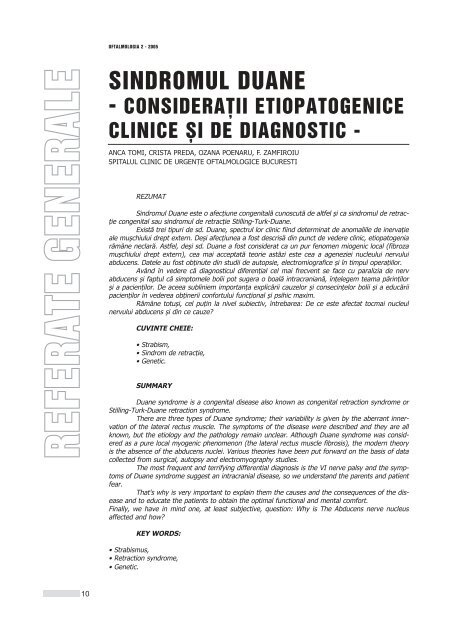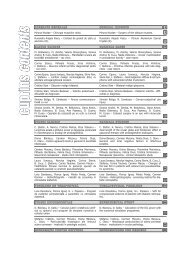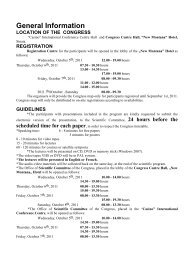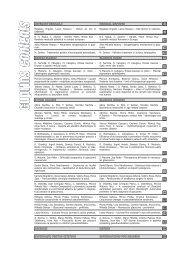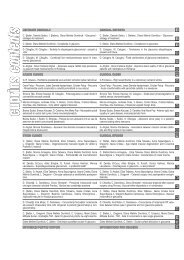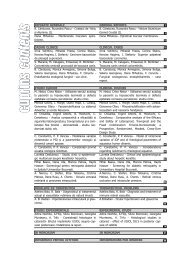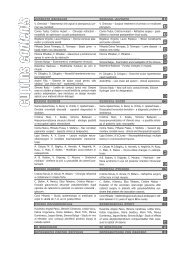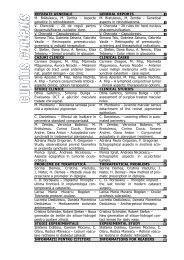Interior 2_2005.qxd - Oftalmologia.ro
Interior 2_2005.qxd - Oftalmologia.ro
Interior 2_2005.qxd - Oftalmologia.ro
Create successful ePaper yourself
Turn your PDF publications into a flip-book with our unique Google optimized e-Paper software.
10<br />
OFTALMOLOGIA 2 - 2005<br />
SINDROMUL DUANE<br />
- CONSIDERA}II ETIOPATOGENICE<br />
CLINICE {I DE DIAGNOSTIC -<br />
ANCA TOMI, CRISTA PREDA, OZANA POENARU, F. ZAMFIROIU<br />
SPITALUL CLINIC DE URGEN|E OFTALMOLOGICE BUCURESTI<br />
REZUMAT<br />
Sind<strong>ro</strong>mul Duane este o afec\iune congenital` cunoscut` de altfel ]i ca sind<strong>ro</strong>mul de retrac-<br />
\ie congenital sau sind<strong>ro</strong>mul de retrac\ie Stilling-Turk-Duane.<br />
Exist` trei tipuri de sd. Duane, spectrul lor clinic fiind determinat de anomaliile de inerva\ie<br />
ale mu]chiului drept extern. De]i afec\iunea a fost descris` din punct de vedere clinic, etiopatogenia<br />
r`m@ne neclar`. Astfel, de]i sd. Duane a fost considerat ca un pur fenomen miogenic local (fib<strong>ro</strong>za<br />
mu]chiului drept extern), cea mai acceptat` teorie ast`zi este cea a ageneziei nucleului nervului<br />
abducens. Datele au fost ob\inute din studii de autopsie, elect<strong>ro</strong>miografice ]i [n timpul opera\iilor.<br />
Av@nd [n vedere c` diagnosticul diferen\ial cel mai frecvent se face cu paralizia de nerv<br />
abducens ]i faptul c` simptomele bolii pot sugera o boal` intracranian`, [n\elegem teama p`rin\ilor<br />
]i a pacien\ilor. De aceea subliniem importan\a explic`rii cauzelor ]i consecin\elor bolii ]i a educ`rii<br />
pacien\ilor [n vederea ob\inerii confortului func\ional ]i psihic maxim.<br />
R`m@ne totu]i, cel pu\in la nivel subiectiv, [ntrebarea: De ce este afectat tocmai nucleul<br />
nervului abducens ]i din ce cauze?<br />
CUVINTE CHEIE:<br />
• Strabism,<br />
• Sind<strong>ro</strong>m de retrac\ie,<br />
• Genetic.<br />
SUMMARY<br />
Duane synd<strong>ro</strong>me is a congenital disease also known as congenital retraction synd<strong>ro</strong>me or<br />
Stilling-Turk-Duane retraction synd<strong>ro</strong>me.<br />
There are three types of Duane synd<strong>ro</strong>me; their variability is given by the aberrant innervation<br />
of the lateral rectus muscle. The symptoms of the disease were described and they are all<br />
known, but the etiology and the pathology remain unclear. Although Duane synd<strong>ro</strong>me was considered<br />
as a pure local myogenic phenomenon (the lateral rectus muscle fib<strong>ro</strong>sis), the modern theory<br />
is the absence of the abducens nuclei. Various theories have been put forward on the basis of data<br />
collected f<strong>ro</strong>m surgical, autopsy and elect<strong>ro</strong>myography studies.<br />
The most frequent and terrifying differential diagnosis is the VI nerve palsy and the symptoms<br />
of Duane synd<strong>ro</strong>me suggest an intracranial disease, so we understand the parents and patient<br />
fear.<br />
That's why is very important to explain them the causes and the consequences of the disease<br />
and to educate the patients to obtain the optimal functional and mental comfort.<br />
Finally, we have in mind one, at least subjective, question: Why is The Abducens nerve nucleus<br />
affected and how?<br />
KEY WORDS:<br />
• Strabismus,<br />
• Retraction synd<strong>ro</strong>me,<br />
• Genetic.


